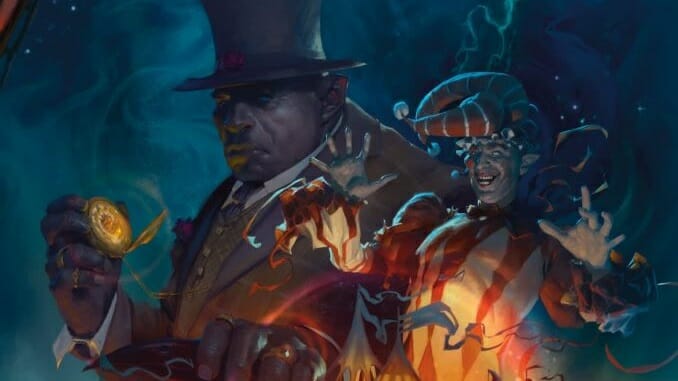Dungeons & Dragons is known for its strangeness and out-there ideas. Abyssal demons and nefarious goblins duel with mages, warlocks, and rogues over hidden treasures and fantastical cities. Playing the game is most often associated with rolling up a character, figuring out who your enemy is, and then taking part in a longform adventure campaign to slay some creatures and restore some kind of order to the world. For the most part, the published adventures from the developer Wizards of the Coast fit this formula nicely, and they’re engaging and pleasurable to read and play through. However, this fall saw the release of The Wild Beyond the Witchlight, a slightly off-kilter adventure, and I could not get through the end of the year without making sure that I highlighted it.
Witchlight has a couple of core assumptions that make it different from your average Dungeons & Dragons adventure. The first is that the entire thing, which could easily take more than 30 or 40 hours to play depending on your group, is designed to be resolved without resorting to combat. D&D’s roots in wargaming mean that it has a robust set of combat mechanics, and the reality is that many of the encounters created within its framework implicitly allow for violence as a last resort. It takes place in fantasy worlds where, when push comes to shove, problems can be resolved with swords and spells.
Witchlight begins from the assumption that this is either unnecessary or a bit boring. Taking place across a plane called the Feywild, a sort of fairyland, Witchlight leans into the conflict resolution of myths, folktales, and jokes rather than epic fantasy. You can collect truffles to get on the good side of an informant. You can sneak around a carnival and pry information from its workers. You can solve a substantial part of one chapter of the campaign by thinking through some riddles supplied by intelligent goats. It is a capacious, weird form of D&D storytelling.
The second core assumption that is being augmented in Witchlight has to do with how the adventure is framed. Broadly speaking, without spoiling anything for those who want to play it, the flow of Witchlight goes like this: Players go to a carnival that travels the multiverse and learns that something bad is going on in the Feywild. They use the carnival as a springboard to make their way to some hidden lands recently subjugated by evil creatures, and they traverse those lands in order to free a deposed ruler from a trap.
In the epic fantasy mode, this would be positioned as a series of levels with boss battles. Frankly, most of the published D&D campaigns feel that way, and it is a familiar mode for anyone who has played D&D extensively. While one can certainly play Witchlight that way, there are extensive guidelines for how to not do so in the written adventure. What is more critical than defeating enemies is discovering pathways from area to area and gaining information from both allies and enemies about the ultimate goal of the campaign. It seems to me that a group could play this entire campaign in such a way that they avoided most of the biggest, baddest creatures entirely, meaning that they could move from interesting encounter to interesting encounter without dealing with anything too big or stressful (the opposite is true also, by the way; you could simply slay your way to the end of the mystery).
I am pointing this out because this reliance on social encounters, skill-based or puzzle encounters, and a general plurality of routes through the adventure means that there is so much else that gets to breathe in the campaign. There are so many well-drawn and notable characters playing in the broad ocean of children’s stories, folktales, and mythology that it is hard to pick favorites. There is a dandelion knight who is attempting to protect a honey bee queen from being captured by a cyclops wielding a giant bee hive as a nest. There is a road-bandit rabbit with a massive scarf who is indebted to a hag. Children captured and stolen away to fairyland can be recruited into a kind of heist-like escape. And there are two dozen or more other well-drawn, easily adapted creatures and situations that are nonstandard D&D fare for players and DMs to get into.
I am gushy about Witchlight because it is the most interested and engaged by a D&D product I have been in a while, and it comes down to the game actively rattling some of its core assumptions so that players can get a novel and fun toolbox of fairy tale things to play with. There is nothing I want more than more things that are like The Wild Beyond the Witchlight in tone and concept, giving players a wider array of types of shenanigans to get up to within the Dungeons & Dragons playbook.
Cameron Kunzelman tweets at @ckunzelman.
